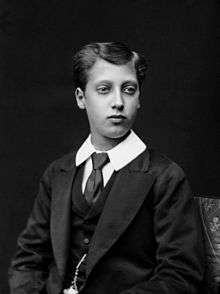Alexander Bassano
| Alexander Bassano | |
|---|---|
 Self portrait, c. 1890s | |
| Born |
Alessandro Bassano 1 May 1829 London, England |
| Died |
21 October 1913 (aged 84) West Acton, London[1] |
| Occupation | Photographer |
Alexander Bassano (10 May 1829 – 21 October 1913) was an English photographer who was a leading royal and high society portrait photographer in Victorian London.[2] His most famous photo was the one of Earl Kitchener in the Lord Kitchener Wants You army recruitment poster during the First World War.
Biography


Alessandro Bassano was the second youngest child of Italian Clemente Bassano, originally a fishmonger of Cranbourne Street, later an oilman and warehouseman of Jermyn Street, London, and his English wife, Elizabeth Browne. He later anglicised his first name to Alexander.[3]
Bassano received early artistic training with artists Augustus Egg and William Beverley. He opened his first studio in 1850 in Regent Street. The studio then moved to Piccadilly 1859-1863, to Pall Mall and then to 25 Old Bond Street in 1877. There was also a Bassano branch studio at 132 King's Road, Brighton from 1893 to 1899.[3]
The Old Bond Street studio was decorated with carbon photographic prints and plaster busts, and was large enough to accommodate an 80-foot panoramic background scene mounted on rollers, which provided a variety of outdoor scenes or court backgrounds. He had taken portraits of William Ewart Gladstone and even Queen Victoria. Bassano's head of Lord Kitchener formed the basis of the First World war recruiting poster Your Country Needs You. Bassano retired from work at the studio around 1903, when the premises were extensively refurbished and relaunched as "Bassano Ltd, Royal Photographers".
The studio moved once again in 1921: a move written about by the Lady's Pictorial at the time. The article described about a million negatives, all systematically numbered, which had to be moved from the cellars of the premises to the new location at 38 Dover Street. The company became "Bassano and Vandyk" in 1964. The following year it incorporated Elliott & Fry, a photographic partnership that had been running in Baker Street since 1863. In 1977, the company became "Industrial Photographic", based at 35 Moreton Street, SW1.[4]
Many glass plates from the Bassano Studios, including some by Alexander Bassano, are held in the National Portrait Gallery, London. The Museum of London holds a large number of the fashion-related plates.
The National Portrait Gallery held an exhibit of his work, Alexander Bassano: Victorian Photographer in 2013, the centenary of his death.[5]
Personal life
He married Adelaide (née Lancaster) in 1850. They had a son, Clement George Alexander, and two daughters, Adelaide Fanny Louise and Camilla Teresa.[3][6]
His sister Louisa Bassano was a noted singer and teacher.
References
- ↑ "Deaths". The Times. The Times Digital Archive. 23 October 1913. p. 1.
- ↑ "Bassano: The Man Himself". National Portrait Gallery. Retrieved 28 September 2016.
- 1 2 3 Hannavy, John (2013). Encyclopedia of Nineteenth-Century Photography. Routledge. p. 117. ISBN 9781135873271.
- ↑ "Bassano, Alexander, 1829-1913, photographer". www.lib.cam.ac.uk. Royal Commonwealth Society Library Photographers Index.
- ↑ "Alexander Bassano: Victorian Photographer". National Portrait Gallery. Retrieved 28 September 2016.
- ↑ Venn, John. Alumni Cantabrigienses: A Biographical List of All Known Students, Graduates and Holders of Office at the University of Cambridge, from the Earliest Times to 1900. Cambridge University Press. p. 180. ISBN 9781108036115. Retrieved 28 September 2016.
Sources
- Michael Pritchard: A directory of London photographers 1841-1908 (Watford: PhotoResearch, 1994)
External links
| Wikimedia Commons has media related to Alexander Bassano. |
- Alexander Bassano at Find a Grave
- Selfportraits
- Photos of his daughters Adelaide Fanny Louise Barber (née Bassano, b. 1850) and Camilla Teresa Serjeant (née Bassano)
- Brighton photographers